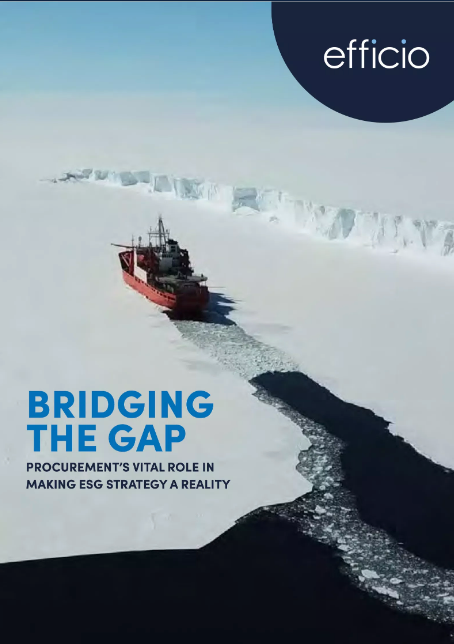The key focus of procurement teams is to drive total cost optimisations while still living up to the organisation’s core values and creating resilience in the supply chain.
Uniting for sustainability
Discussing the evolving ESG landscape, Bederoff Stenvad says: “I really think we are at a point of acceleration in the sustainability space. This comes down to a combination of things. The UN Sustainable Development Goals have had a direct effect by creating a common understanding among stakeholders of the direction the world is heading, businesses are increasingly identifying the opportunities and potential for value creation that is presented in being part of the solution, and increasing regulation and the current convergence of the wide range of multi-stakeholder initiatives aiming to define what sustainability is, is catapulting the ESG space forward at a pace we haven’t seen before.”
Bederoff Stenvad believes that the next important step will be to merge these different approaches and perspectives. “A more harmonised, joint view will make it much easier to make progress. There is increasing consensus across stakeholders that the sustainability agenda should keep moving, and the COVID-19 pandemic helped to put a focus on this,” she notes.
Additionally, companies are realising that taking sustainability into consideration as they develop their businesses is actually a profitable endeavour. “The fact that sustainability does impact the enterprise value positively has led to a general uptake of willingness among companies to engage in this field,” Bederoff Stenvad explains.
A leading mindset
Nordic Capital was very early in defining its commitment to sustainability. “It has always been important to Nordic Capital to invest in good businesses. We adopted our responsible investment policy in 2014, and have continuously developed that approach, defining for our investors and owners of businesses what the minimum requirements are,” Bederoff Stenvad says.
Beyond that, Nordic Capital also developed a toolbox its portfolio companies can leverage to respond to those requests. “We take an active ownership approach within sustainability, with predefined criteria across four categories: strategy, environmental, social, and governance issues. We have defined that we expect all our portfolio companies to have a sustainability strategy in place, preferably with KPIs and targets. They are also expected to know the main sources of their emissions, have proper CO2 reporting in place, and be working actively on reducing emissions,” explains Bederoff Stenvad.
She adds that the company has more recently introduced additional ways to better enable portfolio companies to take action. “We have increased topic-specific training on issues that are really relevant: how you calculate your CO2 emissions, how you work with diversity and inclusion. We have a wide network of experts that can support our portfolio companies in implementing better practices to drive this agenda forward.”
Bederoff Stenvad thinks that the Nordics are leading the way in implementing ESG considerations. “The Nordics and European companies have historically been ahead of American companies. In terms of the number of companies providing sustainability reports, for instance, Europe scores significantly higher than the US. But we also see regional differences in terms of focus, where European companies have put higher emphasis on climate and environmental issues, whereas US companies tend to be more advanced in their diversity and inclusion practices,” she adds.
Aligning Procurement with core values
Talking about the challenges of embedding sustainability across the supply chain, Bederoff Stenvad says that the process requires a mindset shift within both procurement teams and among other stakeholders of the business.
“There needs to be genuine, open discussion about the value that Procurement can bring to the whole business case, and in particular, what role Procurement can play in delivering on the company's sustainability priorities. For example, sustainability and resilience often go hand in hand. Combining these perspectives in your procurement practices can help identify opportunities with both financial and societal impact,” she notes.
With leadership teams increasingly focussing on total cost, there is a clear business case for driving sustainability.
“A number of studies demonstrate that businesses with bad working conditions are less likely to be able to provide good quality products. The key focus of procurement teams is to drive total cost optimisations while still living up to the organisation’s core values and creating resilience in the supply chain,” Bederoff Stenvad claims.
A toolkit for sustainable procurement
Bederoff Stenvad emphasises the importance of developing a set of tools that enables Nordic Capital to gain better quality data from companies on their sustainability practices, including sourcing and supply chain management practices.
“We ensure that our portfolio companies have a supplier code of conduct in place and expect them to have explored the risks and opportunities both from an E, S, and G perspective in their value chains. Traditionally, our assessment has been focussed on processes, but we are getting to a point where the portfolio is becoming more mature, so it is increasingly easier to get access to actual performance metrics at an earlier stage,” she says.
Nordic Capital has a comprehensive approach to enable portfolio companies to deliver procurement value through its cross-portfolio procurement initiative, The Nordic Capital Procurement Optimisation programme (NCPO). The NCPO stands on four strategic pillars, community, talent development, cross portfolio sourcing, and company-specific programmes. Within this environment, Nordic Capital has worked to further enable its portfolio companies to develop sustainable procurement practices. “We developed a Sustainable Procurement Playbook with Efficio, to help procurement organisations within our portfolio to define their role on how they can contribute to the overall business strategy of the company. It also guides them on how to segment their supplier base and work with their suppliers in the most appropriate way to deliver stronger sustainable businesses.”

